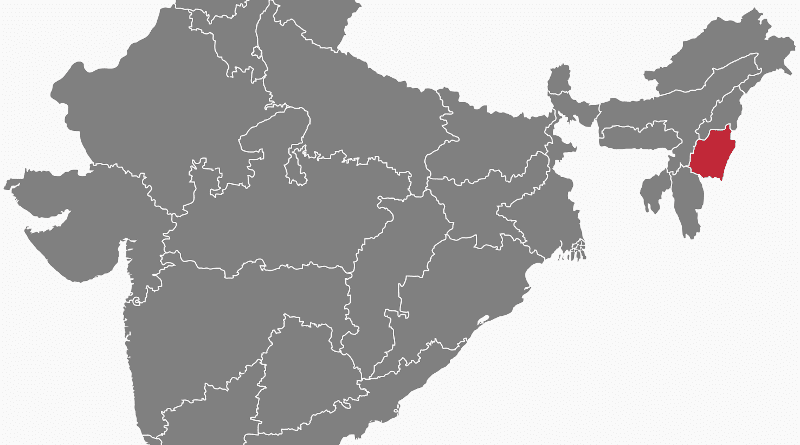INDIA
The Escalating Ethnic Conflict In Manipur – OpEd

Location of Manipur in India. Credit: Wikipedia Commons
The ethnic conflict in the northeastern Indian state of Manipur is at the moment experiencing a deeper dimension of violence due to the activities of the insurgents and the cross border tension between the Indian and Myanmar armies. This has led to increased conflict that has claimed many lives and displaced a large number of people, thus implying the complex social and political factors that characterise the conflict in the region. Manipur is also known as the ‘Land of Jewels’ and is culturally very diverse. It is inhabited by 39 different ethnic groups with different religions such as Hindus, Christians, Muslims, and the Meiteis with Sanamahi as their god. But this diversity is set against a background of conflict. The state’s integration into India in 1949 was not welcomed and subsequent events like the AFSPA in 1958 have further fueled historical injustices. This legislation provides extensive powers to the military in the so-called ‘disturbed areas,’ which mainly concerns the areas in the Northeast and Jammu and Kashmir. AFSPA has been a subject of controversy to human rights bodies and has greatly influenced the tension between Manipur’s state government and the central government in New Delhi.
The situation in the region has worsened in the recent past due to the occurrence of some events. The Manipur High Court got down to hearing a directive on May 3, 2024, to decide the Scheduled Tribe status for the Meitei community, which constitutes a large part of the population of Manipur. This decision has angered the Kuki and Naga indigenous people and led to massive protests that have led to the loss of many lives, burning of buildings and thousands of residents have been forced to seek refuge in relief camps.
The current situation in Manipur is that the clashes are common and the insurgent activities are increasing. Currently, the Myanmar army has escalated its operations against insurgent groups including the Kuki National Army of Burma (KNAB) and the People’s Defense Force (PDF). These encounters have led to losses and major battles with both sides fighting for control in areas that are disputed along the border. Other encounters between Indian Special Forces and different rebel groups have resulted in deaths and injuries. Due to the unpredictable security situation, the attempts to bring back order and stability have been hampered by the occasional fighting that poses a threat to civilians and their confidence.
The emergence of factions such as NSCN-Youth from the parent insurgent groups has further compounded the security dynamics. These factions work autonomously, and instead of helping the authorities and security forces, they only aggravate the situation. Cases of the use of deception by the Indian forces and counterattacks by the militants have escalated the conflict. Such strategies as fake news and cyber warfare have continued to fuel the conflict and create division between the affected communities.
The problems of Manipur are complex and stem from the years of social and political as well as economic exclusion. Existing historical enmity due to non-acceptance of integration into India and other sensitive issues like AFSPA still persist and are major causes of ethnic unrest in Manipur. These tensions define the views on identity and loyalty, which in turn, hinder the creation of a coherent vision of the state’s development.
The emergence of more groups and the complexity of their operations are a major security concern. These groups are known to cross national borders and take advantage of the existing gaps and poor leadership to continue with their acts of terrorism. AFSPA has been criticized for the use of military and security forces in which there are many cases of human rights abuses and excessive force. The militarized response to insurgency has further strained relations between communities and state institutions, undermining efforts to build trust and cooperation
The violence has increased and this has led to the displacement of thousands of civilians and destruction of infrastructure. Humanitarian assistance has been hindered by access limitations and other practical obstacles, which has only worsened the plight of the civilians trapped in the conflict. The fact that Manipur shares its border with Myanmar also complicates the conflict. Insurgent arms trafficking and movement across borders, as well as the seeking of refuge, makes it difficult to control the region and maintain order.
The consequences of such changes for India are rather significant in terms of its image. The inability of the Indian government to contain the situation in Manipur is considered as a major drawback. The increase in intensity of the conflict, the human rights violations perpetrated under the AFSPA, and the displacement of thousands of civilians all paint a rather grim picture of India’s capacity to deliver the rule of law and ensure the safety of its people. The conflict has also drawn criticism from the international community including human rights organizations and this has further worsened India’s image.
Furthermore, the insurgent groups from Myanmar and cross border operations have put question mark on the regional security policy of India. The violence continues to erode India’s attempts at projecting the image of a stable and secure country that is capable of policing its territory. The case of Manipur also presents a problem to the bilateral relations between India and Myanmar in dealing with issues of insurgency and arms smuggling across the border.
The way ahead for Manipur is to work towards the resolution of conflict and healing. It is crucial to start a dialogue with all the stakeholders, including ethnic groups, rebels, and the government. This dialogue should seek to redress past injustices, establish confidence and consensus on the future of the society. It is therefore important to review and possibly change AFSPA to ensure that the security concerns are met while at the same time protecting the rights of individuals. Improving the local administration and supporting the community policing can improve the security situation while increasing the accountability and transparency.
Fostering the socio-economic development programs can help to reduce the socio-economic inequalities that lead to insurgency. Education, health, housing, and employment can offer hope and a chance for a better life, which is a better way to fight terrorism than a military intervention. Relief and assistance to the affected populations and reconstruction of the destroyed facilities are essential. Aid in providing primary needs such as health and education can reduce the humanitarian crisis and help with the rebuilding process.
There is a need to improve cooperation with the neighboring states especially Myanmar to deal with security issues that cut across the borders. Regional cooperation in fighting arms proliferation, cross-border terrorism, and movement of refugees can help in bringing stability and security in the region.
The growing tension in Manipur calls for a more elaborate and participatory strategy in the processes of conflict resolution and healing. It is therefore important to work for the elimination of the causes of violence, encourage dialogue between the parties involved, work for change of governance and security systems and support economic growth as some of the ways of achieving sustainable peace in this volatile area. It is only through continued and sincere attempts and active participation of all the stakeholders that Manipur can hope to come out of the existing problems and emerge as a progressive and a peaceful state in the Indian Union.

Muskan Moazzam
Muskan Moazzam is a student of Quaid e Azam University and has worked with institutes like National Assembly of Pakistan and the Ministry of Foreign Affairs, and is currently associated with some national and international think tanks.
No comments:
Post a Comment